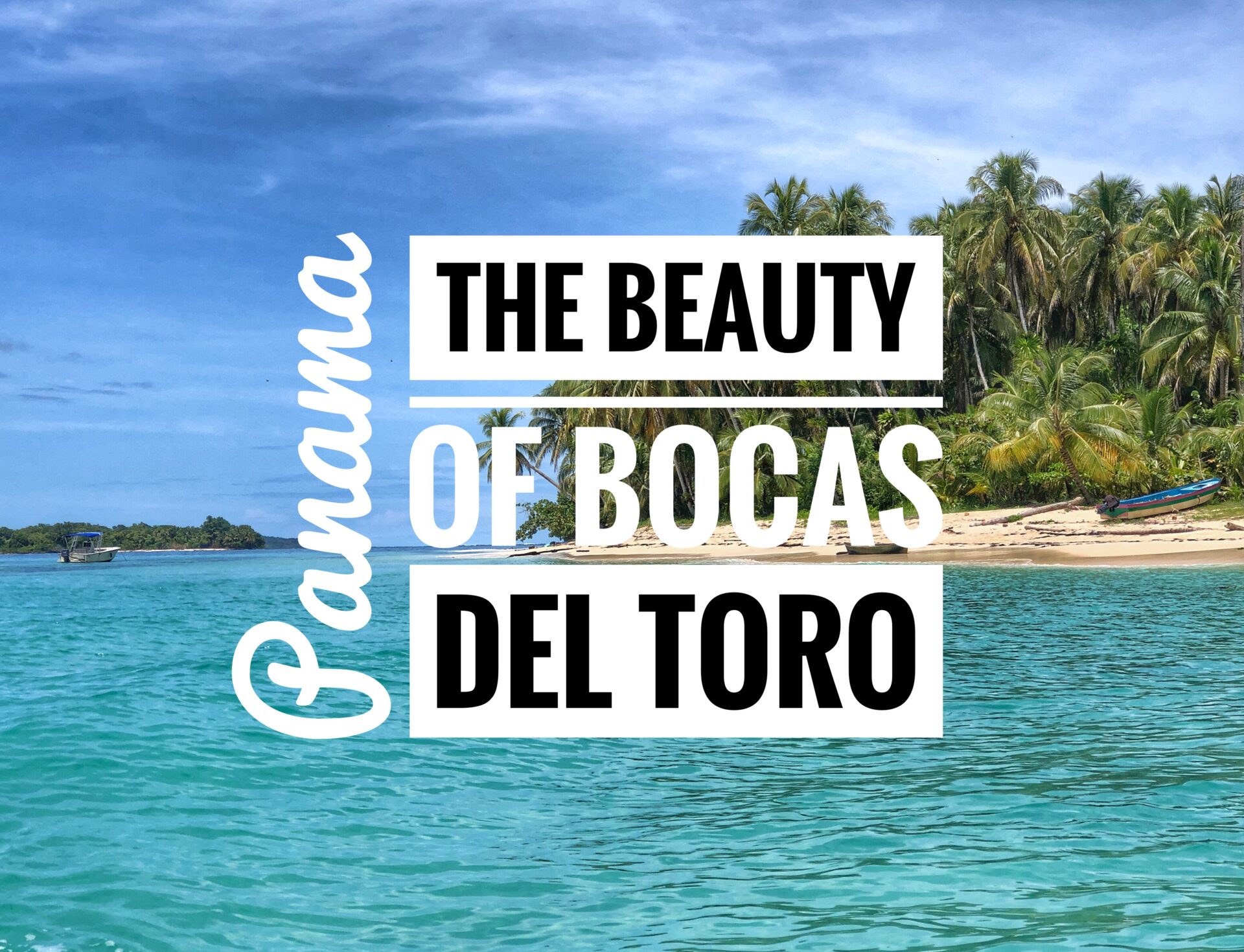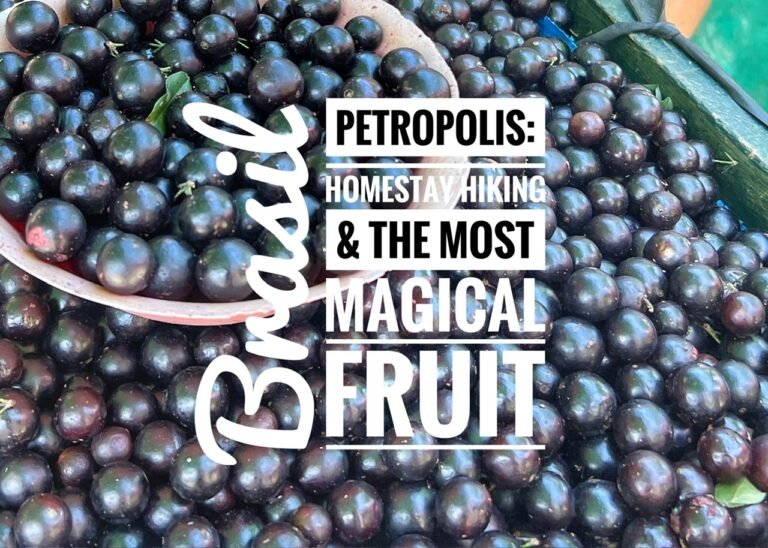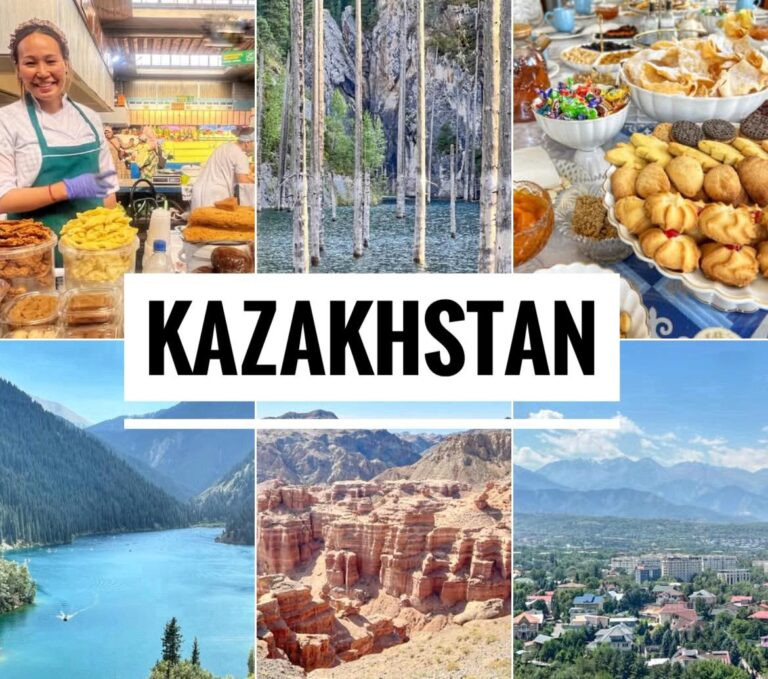
Journeying overland from Lucknow in India to Nepal took some initiative and significantly more determination than we’d expected, made all the more difficult because of the week long Diwali festival celebrations, which we had unfortunately mistimed to coincide with our travel days. The magic transit formula for success ended up being one Uber, one Indian train, two(!) sardine-tinned shared “taxis”, three tuk tuks, and of course some good ole foot power along with our wits. (As a silver lining, all this accumulated modes of transit cost us a mere $20).

And, crossing the India-Nepal border on foot, was naturally, highly haphazard and full of comedic bewilderment…
Ambling along through the border crossing, we were easily identified little snowflakes, and quietly plucked mid-stride from the stream of mass Nepalese bound migration and deposited into the Indian customs office for outbound processing. The Indian customs official took us to a very nondescript immigration office for our exit processing. Had he not pulled us from the street, we easily could have blindly walked right on by. He also looked liked he’d just woken up from a nap. We plopped down in a dark small one room shack with just enough room for a huge desk and two chairs…random papers and ledgers were scattered about, and not a computer in sight. Ah, you gotta love the Indian beaurocrasy! The official was wearing green cargo pants, a white tshirt and a green jacket. Ummm…are you sure you’re a customs official?! Or was this casual Friday at the office? But, he can wear whatever the hell he wants since he had the desired stamp.
In the meantime, all of the Indian nationals trotted, or were bike rick-shawed by some poor sap pedaling three people and their mountains of roller bags towards the Nepalese border. The border is basically an open and easy migration for Nepalese and Indian nationals, with the exception of a few passport glances and gentle pat downs of their bags many come and go regularly.

Plodding along on international dirt seeking stage two…the Nepal entrance stamp and visa. But first we got stopped by a more official-looking lady who checked our bags on the side of the road by poking around our underwear and hand sanitizer. Satisfied we weren’t smuggling gold or antacid tablets, she left our bags in disarray before turning toward the next racially-profiled foreigner.
Tired of turning down the touts we hopped into a persistent rickshaw driver who made us an offer we could not turn down… 20 rupees ($.27) to drive us a ridiculous totally walkable kilometer to the immigration and visa office. Sure enough we were dropped off at the “Immigration Office”, but with no one in sight. Some banging on the screen door of the Nepalese immigration office for a couple minutes, which was locked, Mandy timidly yelled the Nepalese greeting, “Namaste” (a word which, for the record, should never be yelled) and fortunately an official came out and invited us in to have a seat on comfy couches while we filled out our Nepal visa on arrival forms ($50 each for 30 days) and stamp our passports.

Unlike the Indian border, upon walking through the Nepal border, we were not inundated with cheap tuk tuk offers to take us the 5k we needed to go to Nepalgunj. Instead, we found one tuk tuk driver, who agreed to a reasonable 100 Indian rupees ($1.38), and within thirty seconds of the drive, tried to sell us weed and retracted his agreed upon price saying it was too little for how far we were going. Now, the price was 200 rupees. (Not sure if he meant the weed or the ride.) When we said we wouldn’t pay that, in his half-baked haze, he punished us by puttering down the side of the road, about walking speed, while getting incessantly honked at for going too slow. We weren’t budging though, he was only getting 100 rupees. Our first ride into Nepal was just lovely!!!

Welcome to Nepal!! Where the time is 5:45 pm. That would be 15 minutes ahead of India and 5 hours, 45 minutes off from GMT. The odd time difference between Nepal and India has resulted in a national joke that the Nepalese are always 15 minutes late and Indians, 15 early. Believe it or not, it’s not the only place in the world with this odd 45 minute increment. Also, the Chatham Islands in NZ and Australian Central Western Time have this situation. These guys pictured were the (visiting) grandsons of the owner who is 102 years old(!!) and evidently still responsible for the hotel we stayed at.
He may need to retire, or give his grandsons more responsibilities because other things that greeted us in our hotel after our day of hell on the road included: swarms of mosquitoes in the lobby, very questionable sheets, puddles of water in the hallways, leeches crawling out of the bathroom drains (oh, but they were just babies!!!), and of course the endless Diwali fireworks and festivities popped and cracked late into the night. All in all, a rather rough start to Nepal.

But you know what?! Sometimes when you are traveling like we are it’s the little glimmers of goodness that can help you get past the tougher parts… and we had our first Dal Bhat ($2) and it was so damn delicious. This meal is the national staple of Nepal and includes curried vegetables, flavorful greens, pickled veggies, dal (lentil soup), steamed rice, spicy sauce, and a crispy chapati. Little did we know we would later have at least 20 variations during our time in Nepal.

The next day we got to rinse and repeat the process from the day before by going three hours west by local bus to Bardia National Park. We had both our large backpacks on our laps, and our small bags at our feet. But yay! We had seats this time!! This is when we came up with our “sliding Nepali scale o’ comfort meter” to better gauge (and laugh about) the wildly fluctuating comfort levels one experiences on public transit, which can change in a heartbeat.

Dang. Why couldn’t we have had the palace on wheels with free WiFi?! Haha. The buses here promise a lot, yet deliver nothing but some comic relief and false advertising.

We got dropped off at this random intersection and were told to go to Ambasa. We waited…and waited…and waited. No one seemed to know when or if a bus would come, so we reluctantly ended up taking an overpriced tuk tuk to our place in Bardia. Nepal is really testing our travel chops!

At least we met some new friends in the tree nearby who were just hanging around like us…

We couldn’t have been happier to arrive to our cottage in the jungle for the next three nights, Jungle Base Camp. This set is back $8/night and we were on the cusp of our jungle adventure. What a refuge! Things were looking up in Nepal ?

Including this little munchkin…the son of our host was the cutest. In fact, maybe all Nepalese kids are the cutest…
Bardia National Park
Tigers… in Nepal?! Believe it or not, tigers, and rhinos still roam wild in Nepal’s national parks. We sought them out in Bardia National Park in southwestern Nepal when we signed up for a full day (walking) jungle trek ($45/person, including lunch). We chose Bardia because evidently, this park has many more tiger sightings than its touristic neighboring park of Chitwan, in addition to the chance of spotting a rhino.
The day before we began our adventure, we met a fellow backpacker who had an interesting story to tell us…she’d gone jungle trekking and while walking through the thick grasses, Hukum (her guide, and ours) suddenly got very quiet. Out of nowhere, he whisper-yelled, “Ruuuunnnn!!!!” After a safe distance she learned the reason for the sudden departure… a rhino had been about 2-3 meters ahead of them in the tall grass. Rhinos are aggressively territorial so it’s likely he would have charged had they not run. Our eyes got wide upon hearing this story and certainly didn’t lull us to sleep as we prepared to head into the jungle the next morning.

And sure enough…Here’s our rhino! What a fearsome yet remarkable tank of an animal! And check out that horn! It’s impossible not to feel a sense of shock and awe when you literally come face to face with an animal like this. The Indian rhino has one horn while the African and Sumatran rhinos have two, all made from keratin which is the same protein that makes up our hair and fingernails. Devastatingly, the majestic rhino is continues to be illegally hunted and poached the world over solely for its horn, which is sold in Asian markets and bought on the abhorrent and fictional belief that the horn (aka fingernails and hair) has magic curative powers if ingested.

At the entrance to the park and on foot with our guide, Hukum, who carried a large stick to protect us from the only tiger we managed to see. Check out the sissies in their jeeps. ?

The main trail was wide. It only got worrisome when we made a detour into the deeper head-height grasses (prime rhino hiding habitat!) to follow a very narrow foot path.
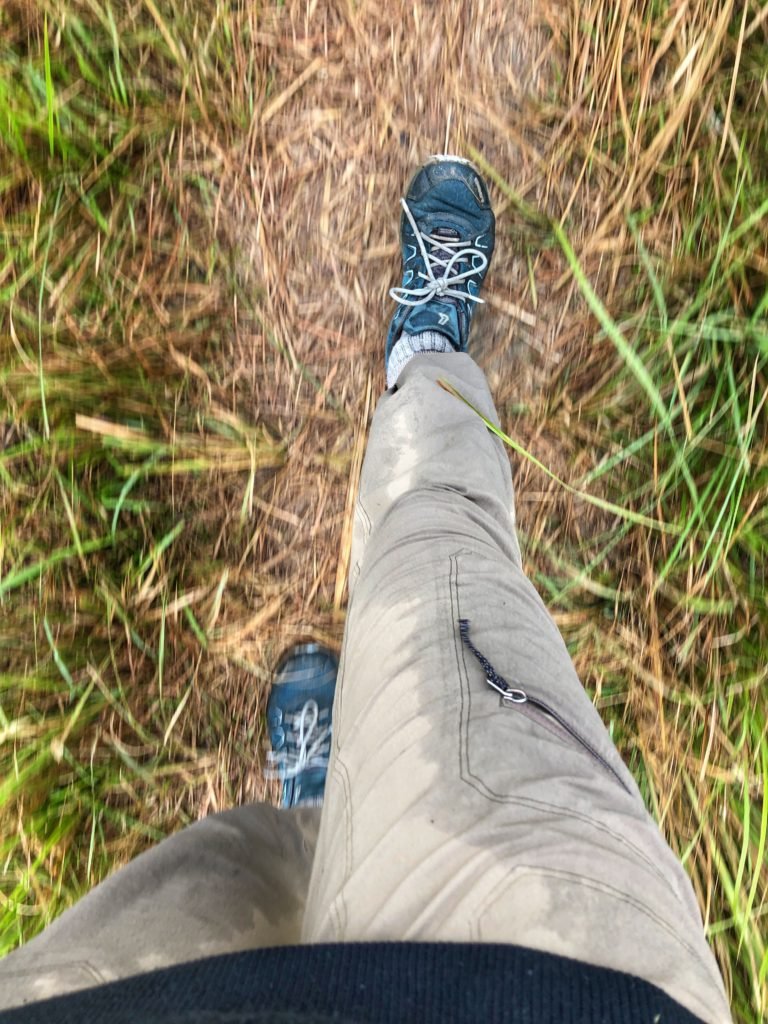
Also, after watching Hukum pluck a blood sucking leech off of his ankle we promptly (and fashionably) tucked our pants into our socks. Haha! Um… suck it…leeches!?!

Just in case our guide’s stick failed us during an attack, Mandy decided to get her own insurance policy… a fearsome stick, complete with two-pronged eye-gouging capabilities, if need be. We were also told, by our guide, to climb a tree if we needed to escape an animal. We were surprised to hear that even two meters up is apparently enough of a deterrent for rhinos AND tigers. Leopards being the only tree climbing predators we needed to worry about. The only problem with this escape route through the grasslands of Bardia though, is…there is a distinct lack of trees to climb.

Emerging from the grassland we approached a wide river where we waited…and waited…and waited. Tiger trekking is not a sport for the impatient. (Aka…Mandy.) It seems it’s more practical to let the tigers come to you, rather than seeking them out. Hukum even climbed a tree to get a better lookout for us, and pointed out a crocodile on the riverbank. The crocodile looked more like a baked potato with a tail, and didn’t move a muscle for the entire hour and a half that we sat in this spot. Other than that, we saw a deer. Not exactly riveting.

Getting inspired by the monkeys, and practicing her tree climbing escape moves, Mandy was a natural!

Greg stays safely with the tigers on the ground below.

As she gazes into the jungle…

From all the way up here, she spots…at last…our first rhino!!!

Actually, the only thing she really spotted were these insects, which ironically have spots. Hukum said they were a type of lady bug, but after researching it we believe it was a shield bug. Maybe.

Oh but we spotted lots of EVIDENCE of the elusive tigers. This included some day old tiger poo, (yes, we just posted a poo picture on Facebook), and a fresh tiger paw print. Also, at top right, supposedly a track that a python makes when it slithers across the trail. In the end, after 12 hours walking (and waiting) through the park this evidence of the tigers and rhinos existence is rather disappointingly all we saw on the trek. Animal sightings are not guaranteed in the wild, and we knew that. ??♀️ ?♂️

So, full disclosure, as you may have guessed, the very close encounter rhino photo posted at the beginning was actually not until the end of our trek at the rhino rehab center that has been set up to help injured rhinos. Agh, you win some and lose some. The day we chose to do our jungle trek was not our lucky day for spotting a tiger. Or was it? At least we didn’t have to run for our lives from a rhino…or tiger. ?

At least the monkeys were cute…

Bardia to Butwal (Not Lumbini)
The village of Thakudwara near Bardia N.P. was a very chill place where everyone said namaste, but were never intrusive or superficial. Namaste, the familiar, yogi term is widespread as a greeting in Nepal and literally translates to “I bow to the light within you,” which is seen as a sign of respect and reverence. It was delightful to have a few days of downtime in the village just outside Bardia National Park.

We found a perfect little perch to grab a tasty beer. Until a nest of wasps started swarming overhead making us a wee bit skittish.

Have we mentioned that in very budget-friendly Nepal, beer is far from it? After years of very cheap $1-2 beer prices, the government has swooped in with sin taxes to fill their coffers. Boo. A big bottle of Gherka craft beer now costs on average 450-650 rupees (about $4-$6) so for us, beer in Nepal has only been a special treat.

The haze is prevalent in Nepal. Although it didn’t feel too bad in the south lowlands, poor air quality never allowed the sun to fully shine, instead only giving us these very strange filtered sun type days.

Walking through the village made us grateful for our cozy jungle cottage.

It was time to head to Lumbini the birthplace of Buddha. Little did we know the tumultuous bus trip en route to Lumbini that lay ahead. The next day, our “tourist bus” from Bardia to Butwal was supposedly reserved for us by our hotel host. A tuk tuk picked us up promptly at 6:30, puttered us 20 minutes to the “station” (a single concrete bench at a bustling intersection) and the driver deposited us with a man who would allegedly get us on the right (tourist) bus to Lumbini. First he took 1400 rupees from us (about $12), gave us a seemingly legit, ticket and then told us the bus would come at 8, not 7, as we were told. No problem we thought. We had a cup of tea from this roadside stand and met the family who runs it.

…Three and a half hours later however, our bus still had not arrived. Where we waited…and waited…and waited some more.
When the next very crowded local bus pulled up, we observed our supposed helper give an obvious bribe to the bus driver, who motioned for us to quickly get on, and in mumbled Nep-glish said we had two seats in back (which he clearly used our excessive amount “tourist bus” cash to pay other occupants to vacate.) With no other option, we watched in dismay as our backpack homes were tossed hastily atop the roof and crawled our way over a mountain of people, clusters of cabbage and 100-pound bags of rice (because why not?) We eventually found the way to a seat near the back. Seat. Singular. The “other” seat was evidently a figment of the schemer’s imagination.

Thus, we began taking two-hour shifts of sitting on the rice bag in the aisle, while using our packing cubes as cushions to avoid puncture wounds, and/or standing on the rubble-filled and winding “highway.” Mandy was especially excited to share her floor space with an animated five-year-old who wouldn’t stop singing or eating crumbs of food off the revolting floor, and an infant whose exposed diaperless and dainty willy was floopily bouncing back and forth while remaining pointedly aimed at her face.
Fortunately after about five hours, we both managed to score actual seats. All this fun for the low price of triple what the locals all paid for this ten-hour journey. ? Nepal is literally a country of highs and lows.
After 10 hours of this pure joy ride…and our winner for the worst bus ride ever, we gleefully abandoned ship into the busy transient town of Butwal.
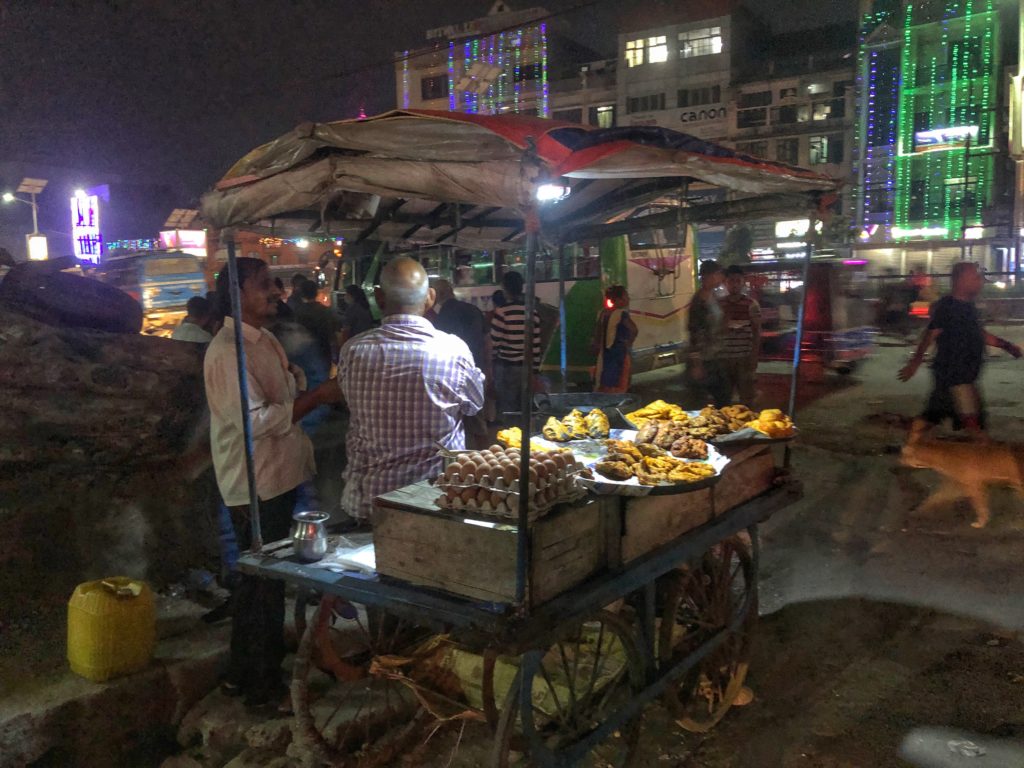
Arriving to Butwal, (because there was no way we were now heading to Lumbini,) we were elated to stretch our legs and quickly find our hotel where a lovely Nepalese women’s choir was singing in the streets, soon to be replaced with thumping bass which brought back immediate panic from our nights in Ethiopia during the three day wedding mad house. Yes, breaking point. ? Another roller coaster day in Nepal…The next day, however, things looked up as we enjoyed visiting the night market in Butwal after grabbing some totally delicious grub…

…as well as diving into the most divine piece of chocolate, and milk, we’ve had in quite awhile. This bakery, called Black Forest Cake Shoppe, seemed to be the pride and joy of Butwal.

It was so good it even had a police officer guarding the entrance.

Alright, enough of that. Now off to Pokhara to climb some mountains…
And thanks to Rabin, at Vision Lumbini Tours, we also managed to snag a tourist bus (with real actual seats!!) to Pokhara for our next leg of the journey to the Annapurna, which for us, was a palace on wheels for $11/total. Ah yes, in travel, knowing when to lower expectations sometimes can make all the difference.

